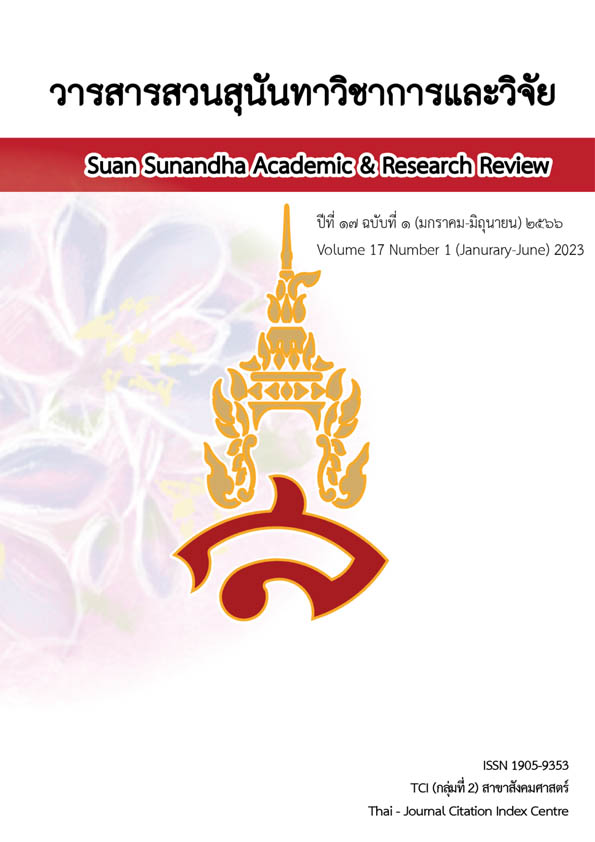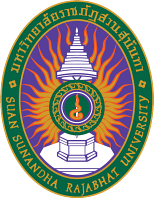ผลของการใช้วงจรการเรียนรู้ 5E ร่วมกับกลยุทธ์แนวเทียบ เพื่อการแก้ปัญหา ความเข้าใจคลาดเคลื่อนในมโนทัศน์ เรื่อง โครงสร้างและหน้าที่ของเซลล์ ของนักเรียนชั้นมัธยมศึกษาปีที่ 4
คำสำคัญ:
ความเข้าใจมโนทัศน์, โครงสร้างและหน้าที่ของเซลล์, วงจรการเรียนรู้ 5E ร่วมกับ กลยุทธ์แนวเทียบบทคัดย่อ
การส่งเสริมนักเรียนให้มีความเข้าใจมโนทัศน์เรื่องโครงสร้างและหน้าที่ของเซลล์ได้อย่างถูกต้อง
เป็นความท้าทายสำคัญของครูผู้สอนชีววิทยา งานวิจัยปฏิบัติการในชั้นเรียนนี้มุ่งแก้ปัญหาความเข้าใจคลาดเคลื่อนในมโนทัศน์ทางชีววิทยา เรื่อง โครงสร้างและหน้าที่ของเซลล์ มีวัตถุประสงค์เพื่อศึกษาผลการใช้วงจรการเรียนรู้ 5E ร่วมกับกลยุทธ์แนวเทียบ เพื่อการแก้ปัญหาความเข้าใจคลาดเคลื่อนในมโนทัศน์
เรื่อง โครงสร้างและหน้าที่ของเซลล์ กลุ่มเป้าหมายคือ นักเรียนชั้นมัธยมศึกษาปีที่ 4 ปีการศึกษา 2565 จำนวน 42 คน เก็บข้อมูลโดยใช้แบบสอบวินิจฉัย 2 ระดับ ครอบคลุมมโนทัศน์หลัก 3 เรื่อง ได้แก่ 1) ส่วนที่ห่อหุ้มเซลล์ 2) นิวเคลียส และ 3) ไซโทซอลและออร์แกเนลล์ต่าง ๆ ระยะเวลาในการเก็บรวบรวมข้อมูล
3 สัปดาห์ ผู้วิจัยวิเคราะห์ข้อมูลด้วยสถิติความถี่และร้อยละของจำนวนคำตอบของนักเรียนในแต่ละมโนทัศน์ ผลการวิจัยพบว่า นักเรียนส่วนใหญ่ยังมีความเข้าใจอยู่ในระดับไม่มีความเข้าใจมโนทัศน์ หรือไม่แสดงคำตอบ (NU) คิดเป็นร้อยละ 55.65 แต่มีแนวโน้มที่จะมีระดับความเข้าใจมโนทัศน์ที่ถูกต้อง (SU)
เพิ่มมากขึ้นจากร้อยละ 3.37 เป็นร้อยละ 25.70 ระหว่างการเก็บรวบรวมข้อมูล นอกจากนั้นผู้วิจัยยังพบว่า นักเรียนมีแนวโน้มที่จะมีความเข้าใจในเนื้อหาได้อย่างสอดคล้องกับมโนทัศน์ทางวิทยาศาสตร์ และเข้าใจธรรมชาติของวิชาวิทยาศาสตร์มากยิ่งขึ้น อีกทั้งนักเรียนยังมีปฏิสัมพันธ์ในการเรียนเพิ่มขึ้น ดังนั้นในงานวิจัยครั้งต่อไป ผู้วิจัยอาจศึกษาผลของการจัดการเรียนรู้โดยใช้วงจรการเรียนรู้ 5E ร่วมกับกลยุทธ์แนวเทียบ
เพื่อพัฒนาการเรียนรู้ของผู้เรียนทั้งผลสัมฤทธิ์ทางการเรียนชีววิทยา หรือความยึดมั่นผูกพันทางการเรียนได้
เอกสารอ้างอิง
Arsingsamanan, W., Sawangmek, S., & Nakkuntod, M. (2017). Action research for enhancing genetics conception of grade 10 students by learning management using scientific argumentation in socioscientific issues. Social Sciences Research and Academic Journal, 12(35), 87-100 (In Thai).
Bangthamai, W., & Lertdechapat, K. (2022). The effect of using the 5E instructional model with stop motion on tenth grade students’ conceptual understanding in the topic of DNA technology. Retrieved December 25, 2022, from https://drive.google.com/file/d/
XvUu2G-a_ahzo3PS4lZFyHdllZj4DmPR/view (In Thai)
Kanli, U. (2015). Using a two-tier test to analyse students' and teachers' alternative concepts in astronomy. Science Education International, 26(2), 148-165.
Kemmis, S., & Mctaggart, R. (1998). The action research planner, Waurn Ponds (3rd ed.). Victoria: Deakin University Press.
Kete, R., Horasan, Y., & Namdar, B. (2012). Investigation of the conceptual understanding difficulties in 9th grade biology books about cell unit. Elementary Education Online, 11(1), 95-106.
Koatthong, Y., & Pavaputanon, L. (2015). The Study of Scientific Conceptual Change on Cell Using Analogy Approach for Grade 10 Students. Journal of Education Graduate Studies Research, 9(3), 157-164 (In Thai).
Lakhan, N., Latwong, T., & Chaiprasert, P. (2021). A study of scientific concepts and constructing scientific model ability using model-based learning for 12th grade students. Journal of Education Naresuan University, 23(3), 144-158 (In Thai).
Ministry of Education. (2017). Indicators and content areas in science (revised curriculum A.D. 2017) according to basic education core curriculum B.E. 2551 (A.D. 2008). Bangkok, : The Agricultural Co-operative Federation of Thailand (In Thai).
Nimlaor, P., Kaewdee, S., & Pollawatn, R. (2017). Effects of using context-based learning approach on conceptual understanding in biology of upper secondary school students. Online Journal of Education, 12(2), 224-238 (In Thai).
Orgill, M., & Thomas, M. (2007). Analogies and the 5E model. Retrieved October 10, 2022, from https://eric.ed.gov/?id=EJ758684
Praditduang, R. (2019). Effects of using analogy strategy incorporated with 5E learning cycle on analytical thinking ability and chemistry learning achievement of upper secondary school students. Retrieved September 13, 2022, from http://cuir.car.chula.ac.th/handle/
/64757 (In Thai)
Rodpan, K., & Lawthong, N. (2022). Development of three-tier parallel diagnostic test based on misconceptions in science for lower secondary school students. Journal of Educational Measurement, 39(105), 1-12 (In Thai).
Smith, E. L., Blakeslee, T. D., & Anderson, C. W. (1993). Teaching strategies associated with conceptual change learning in science. Journal of Research in Science Teaching, 30(2), 111-126.
Suwarak, S., & Chanprathak, A. (2021). The development of active science learning activities on the topic of cellular respiration for mathayomsuksa 4 student. Rajabhat Maha Sarakham University Journal, 15(2), 41-54 (In Thai).
Ültay, N., & Çalik, M. (2016). A comparison of different teaching designs of ‘Acids and Bases’ Subject. Eurasia Journal of Mathematics, Science & Technology Education,, 12(1), 57-86.
Westbrook, S. L., & Marek, E. A. (1992). A cross-age study of student understanding of the concept of homeostasis. Journal of Research in Science Teaching, 29(1), 51-61.
ดาวน์โหลด
เผยแพร่แล้ว
รูปแบบการอ้างอิง
ฉบับ
ประเภทบทความ
สัญญาอนุญาต
ลิขสิทธิ์ (c) 2023 สถาบันวิจัยและพัฒนา มหาวิทยาลัยราชภัฎสวนสุนันทา

อนุญาตภายใต้เงื่อนไข Creative Commons Attribution-NonCommercial-NoDerivatives 4.0 International License.
บทความที่ได้รับการตีพิมพ์เป็นลิขสิทธิ์ของ สถาบันวิจัยและพัฒนา มหาวิทยาลัยราชภัฎสวนสุนันทา
ข้อความที่ปรากฏในบทความแต่ละเรื่องในวารสารวิชาการเล่มนี้เป็นความคิดเห็นส่วนตัวของผู้เขียนแต่ละท่านไม่เกี่ยวข้องกับมหาวิทยาลัยราชภัฎสวนสุนันทา และคณาจารย์ท่านอื่นๆในมหาวิทยาลัยฯ แต่อย่างใด ความรับผิดชอบองค์ประกอบทั้งหมดของบทความแต่ละเรื่องเป็นของผู้เขียนแต่ละท่าน หากมีความผิดพลาดใดๆ ผู้เขียนแต่ละท่านจะรับผิดชอบบทความของตนเองแต่ผู้เดียว






